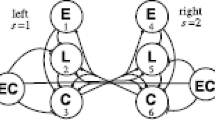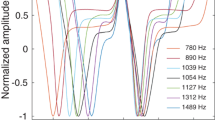Abstract
Crayfish swimmeret system shows rhythmic, coordinated behavior when the command fibers are stimulated chronically by electrical pulses, and the oscillating frequency becomes faster with increasing stimulus frequency. This behavior is organized by the distributed neural oscillators in the abdominal ganglia. We investigated the dynamics of the neural oscillators which are controlled by command fibers. Phase resetting experiment technique was used for this purpose; a temporary cessation of commanding pulses, which was regarded as suppressive perturbation for the neural oscillator, was applied to the chronically stimulated oscillator, and phase transition curves (PTCs) were measured. For the short cessation of command pulses, type 1 PTCs were obtained. With increasing cessation length, the PTC shifted downward, and finally changed into type 0. We also measured PTCs for temporarily increased stimulus frequency, which was an excitatory perturbation for the neural oscillator and increased the frequency of the oscillation transiently. For the short excitatory perturbation, the PTCs were also type 1 and shifted upward. PTCs changed their shapes from type 1 into type 0, as increasing the perturbation length. These shapes of the PTCs contain important information about the properties of the neural oscillator. Analyzing these PTCs, we present a phase plane diagram which describes the character of the command control of the neural oscillator.
Similar content being viewed by others
References
Davis, W.J.: Reflex organization in the swimmeret system of the lobster. 1. Intrasegmental reflexes. J. Exp. Biol. 51, 547–563 (1969)
Davis, W.J., Kennedy, D.: Command interneurons controlling swimmeret movements in the lobster. 1. Types of effects on motoneurons. J. Neurophysiol. 35, 1–12 (1972)
Davis, W.J., Kennedy, D.: Command interneurons controlling swimmeret movements in the lobster. 2. Interaction of effects on motoneurons. J. Neurophysiol. 35, 13–19 (1972)
Davis, W.J., Kennedy, D.: Command interneurons controlling swimmeret in the lobster. 3. Temporal relationships among bursts in different motoneurons. J. Neurophysiol. 35, 20–29 (1972)
Heitler, W.J., Pearson, K.G.: Non-spiking interactions and local interneurones in the central pattern generator of the crayfish swimmeret system. Brain Res. 187, 206–211 (1980)
Hughes, G.M., Wiersma, C.A.G.: The co-ordination of swimmeret movements in the crayfish, Procambarus clarkii (Girard). J. Exp. Biol. 37, 675–670 (1960)
Ikeda, K., Wiersma, C.A.G.: Autogenic rhythmicity in the abdominal ganglia of the crayfish; the control of swimmeret movements. Comp. Biochem. Physiol. 12, 107–115 (1964)
Kawato, M., Suzuki, R.: Biological oscillators can be stopped Topological study of a phase response curve. Biol. Cybern. 30, 241–248 (1978)
Kawato, M.: Transient and steady phase response curves of limit cycle oscillators. J. Math. Biol. 12, 13–30 (1981)
Kennedy, D., Takeda, K.: Reflex control of abdominal flexor muscles in the crayfish. 1. The twitch system. J. Exp. Biol. 43, 211–227 (1965)
Kennedy, D., Davis, W.J.: Organization of invertebrate motor systems. In: Handbook of physiology, Vol. 1, pp. 1023–1087, Kandel, E.R. (ed.) Bethesda, MD: Am. Physiol. Soc. 1977
Kristan, W.B., Jr.: The generation of rhythmic motor pattern. In: Information processing in the neurvous system, pp. 241–261, Pinsker, H.M., Willis, W.D., Jr. (eds.). New York: Raven Press 1980
Malchow, D., Nanjundiah, V., Gerisch, G.: pH-oscillation in cell suspensions of Dictyostelium discoideum; their relation to cyclic-AMP signals. J. Cell. Sci. 30, 319–330 (1978)
Pinsker, H.M.: Aplysia bursting neurons as endgenous oscillators. 1. Phase response curves for pulsed inhibitory synaptic input. J. Neurophysiol. 40, 527–543 (1977)
Pinsker, H.M., Bell, J.: Phase plane description of endogenous neuronal oscillators in Aplysia. Biol. Cybern. 39, 211–221 (1981)
Pittendrigh, C.S., Bruce, V.G.: An oscillator model for biological clocks. In: Rhythmic and synthetic process in growth, pp. 75–109, Rudnick, D. (ed.). Princeton: Princeton University Press 1957
Selverston, A.J.: Are central pattern generators understandable? Behav. Brain Sci. 3, 535–571 (1980)
Stein, P.S.G.: Neural control of interappendage phase during locomotion. Am. Zool. 14, 1003–1016 (1974)
Winfree, A.T.: The geometry of biological time. New York, Heidelberg, Berlin: Springer 1980
Yamanishi, J., Kawato, M., Suzuki, R.: Studies on human finger tapping neural networks by phase transition curves. Biol. Cybern. 33, 199–208 (1979)
Wiersma, C.A.G., Ikeda, K.: Interneurons commanding swimmeret movements in the crayfish, Procambarus clarkii (Girard). Comp. Biochem. Physiol. 12, 509–525 (1964)
Author information
Authors and Affiliations
Rights and permissions
About this article
Cite this article
Tatsumi, H., Suzuki, R. Phase plane description of crayfish swimmeret oscillator. Biol. Cybern. 47, 59–68 (1983). https://doi.org/10.1007/BF00340070
Received:
Issue Date:
DOI: https://doi.org/10.1007/BF00340070




